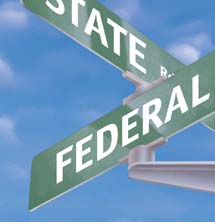A New Litigation Strategy For State And Local Governments:
Removal to Federal Courts
State and local governments increasingly are removing to federal
court actions filed against them in state court that contain both state
law and federal claims. This trend has increased federal court
litigation of what used to be considered "state court" claims.
By Anne Berleman Kearney
With its decisions this past year in International
College of Surgeons and Schacht, the Supreme Court has taken a further
step to expand federal court jurisdiction. These decisions thus require
a change in thought regarding the relationship between federal and state
law claims in an action brought against a state or local
government.
A number of state and local governments are turning to a new and
surprising strategy when actions that contain both state law claims and
federal claims are filed against them in state court: They are removing
these cases to federal court. Although private parties have long removed
such cases to federal court, it is surprising that state and local
governments, which traditionally have looked to state courts to protect
their interests, are now looking to federal courts to provide that
protection. It is not entirely clear what is behind this trend - one
could posit a more conservative federal judiciary or, with the
decentralization of political power, state courts that are more likely
to be sympathetic to plaintiffs' interests than to the government's, or,
simply, the efficiency of federal courts. But the trend can be seen
clearly in two recent U.S. Supreme Court cases overturning decisions of
the Seventh Circuit.
This government removal strategy thus far has proved successful
despite several apparent obstacles that would not arise in private
litigation. The best example of this is the recent U.S. Supreme Court
decision in City of Chicago v.
International College of Surgeons,1
which held that Chicago could remove to federal court a developer's
challenge to the City Landmark Commission's denial of demolition
permits. Even though this case was by all appearances a garden-variety
appeal from a municipal administrative decision, the Supreme Court
concluded that it was sufficient for purposes of federal court
jurisdiction that the developer had included in its suit a federal
constitutional challenge to the Commission's administrative ruling.
Wisconsin also has adopted this removal strategy, and recently saw
the strategy succeed in the U.S. Supreme Court. In Schacht v.
Wisconsin Dep't of Corrections,2
handed down on June 22, 1998, the Supreme Court unanimously held that
Wisconsin could remove to federal court the suit of a correctional
officer against a state agency (specifically, the Department of
Corrections) and certain state officials in their individual and
official capacities.3 The Court determined
that the action was properly removed because the correctional officer's
suit included claims alleging violations of his federal constitutional
rights, and even though some of his other claims - those against the
state agency and state officials in their official capacity - could not
be litigated in federal court since they were barred by the doctrine of
sovereign immunity.4
 Because Wisconsin's successful position in
Schacht raises some of the same analytical issues as those
considered by the Supreme Court in International College of
Surgeons, it is helpful first to explore the basis for this earlier
decision. In International College of Surgeons, the Court held
that certain actions challenging decisions of state and local
governments may be removed to federal court, even where these challenges
predominantly include state law claims that are brought by in-state
citizens and that therefore do not fall within the original jurisdiction
of federal courts.5
Because Wisconsin's successful position in
Schacht raises some of the same analytical issues as those
considered by the Supreme Court in International College of
Surgeons, it is helpful first to explore the basis for this earlier
decision. In International College of Surgeons, the Court held
that certain actions challenging decisions of state and local
governments may be removed to federal court, even where these challenges
predominantly include state law claims that are brought by in-state
citizens and that therefore do not fall within the original jurisdiction
of federal courts.5
In determining whether the local government had properly removed the
case to federal court, the Court in International College of
Surgeons first looked to whether there were any claims "arising
under" federal law. Because such claims were present, the Court directed
its attention to the supplemental jurisdiction statute, 28
U.S.C. §1367.6 That statute,
enacted in 1990 and not previously relied upon by the Court, provides
that "in any civil action of which the district courts have original
jurisdiction [e.g., through the diversity or federal-question
statutes], the district courts shall have supplemental jurisdiction over
all other claims that are so related to claims in the action within such
original jurisdiction that they form part of the same case or
controversy."7 The supplemental jurisdiction
statute combines the doctrines of pendent and ancillary jurisdiction,
enabling all claims that arise from "a common nucleus of operative fact"
to be brought in federal court.8
The majority in International College of Surgeons found that
this recent jurisdictional statute applied and that its terms were met
because the complaints filed by the developer against the local
government contained well-pleaded issues "arising under" federal law,
namely, claims of federal constitutional due process and equal
protection violations.9 Moreover, the
developer's state law claims, which asked for judicial review of the
Landmark Commission's determinations based upon a deferential
on-the-record standard, were sufficiently related to the federal
constitutional claims.10 Thus, the Court
determined that the entire case fell within the federal court's
jurisdiction - the federal claims within the federal court's original
jurisdiction and the state law claims within the federal court's
jurisdiction by virtue of the supplemental jurisdiction statute.11
In rendering its decision in International College of
Surgeons, the Supreme Court reversed the Seventh Circuit, which had
ruled that the action against Chicago could not be removed because the
action - even though it contained some federal court claims - also
contained state law claims that fell outside the federal court's
original jurisdiction.12 Specifically, the
majority rejected the view embraced by the Seventh Circuit that the
nature of the state law claims should be determinative of federal court
jurisdiction.13 Instead, the Court shifted
the focus away from the state law claims to the federal claims because
"[t]he district court's original jurisdiction [and thus the basis for
federal court jurisdiction] derives from [the developer's] federal
claims, not its state law claims."14
Moreover, the majority stated, "[n]othing in the jurisdictional statutes
suggests that the presence of related state law claims somehow alters
the fact that [the] complaints, by virtue of their federal claims, were
'civil actions' within the federal court's 'original
jurisdiction.'"15 Indeed, Justice O'Connor,
writing for the Court, concluded that the Seventh Circuit's
interpretation "would effectively read the supplemental jurisdiction
statute out of the books" since the law's very purpose was "to allow
[federal] courts to exercise pendent jurisdiction over claims as to
which original jurisdiction is lacking."16
 In dissent, Justice Ginsburg (joined by Justice
Stevens) was taken aback by the apparent scope of the Court's ruling.
Indeed, she termed the majority's ruling in International College of
Surgeons a "watershed decision" and a "landmark result" because, in
her view, it allows a state's system for handling appeals from
administrative agencies to the courts to be "displaced or dislodged" by
any defendant that wants to remove a case to federal court whenever
state law claims are joined with some federal claims or whenever there
is diversity of citizenship.17
In dissent, Justice Ginsburg (joined by Justice
Stevens) was taken aback by the apparent scope of the Court's ruling.
Indeed, she termed the majority's ruling in International College of
Surgeons a "watershed decision" and a "landmark result" because, in
her view, it allows a state's system for handling appeals from
administrative agencies to the courts to be "displaced or dislodged" by
any defendant that wants to remove a case to federal court whenever
state law claims are joined with some federal claims or whenever there
is diversity of citizenship.17
The dissent thought that this was not only unwise as a policy matter,
but contrary to two earlier Supreme Court decisions, Chicago, R.I. & P.R.
Co. v. Stude18 and Horton v. Liberty Mutual
Insurance Co.19 These cases
suggest that federal district courts do not have original jurisdiction
to sit as appellate courts where a state administrative ruling is being
challenged on the basis of the administrative record.20 The dissent unsuccessfully proposed that, based
on these precedents, the nature of the state law claims should be, at
least in some part, determinative of the federal court's jurisdiction
over an action.21
Given this International College of Surgeons backdrop, the
Court's decision in Schacht has a familiar look about it. In
Schacht the Court again focused on the federal claims that were
present in the suit.22 In doing so, the
Court rejected the Seventh Circuit's reasoning that since some of the
correctional officer's claims did not fall within the federal court's
original jurisdiction because of the sovereign immunity bar, the action
could not be removed to federal court at all.23
Instead, relying upon International College of Surgeons, the
Court emphasized in Schacht that "the presence of even one
claim 'arising under' federal law is sufficient to satisfy the
requirement that the case be within the original jurisdiction of the
district court for removal."24 The Court
reasoned that "[the] federal claims suffice to make the actions 'civil
actions' within the 'original jurisdiction' of the district courts for
purposes of removal."25 And, as was the
case in International College of Surgeons, the Court in
Schacht concluded that the presence of related claims over
which the district court may not have original jurisdiction (here, the
claims implicating Wisconsin's sovereign immunity) does not destroy
removal jurisdiction.26
With its decisions this past year inInternational College of
Surgeons and Schacht, the Supreme Court has taken a
further step to expand federal court jurisdiction. These decisions thus
require a change in thought regarding the relationship between federal
and state law claims in an action brought against a state or local
government.
In particular, because of the success of state and local governments
in these cases, both plaintiffs and state and local governments alike
effectively have been granted greater access to federal courts.
Plaintiffs now can initially file in federal court when their lawsuits
raise federal claims and their state law claims - almost whatever their
nature and even if they are as mundane as the land-use challenge in
International College of Surgeons - arise from the same set of
facts. That is because in International College of Surgeons the
premise of the decision that Chicago could remove was that the College
could have brought its land-use challenge in federal court in the first
place (so long as it was joined with the federal claims). Likewise, the
premise in Schacht was that the federal court would have had
original jurisdiction over the suit if it originally had been filed
there. As for state and local governments named as defendants, these
decisions establish that they may remove such actions to federal court
if plaintiffs have opted for state court instead. Simply put, the
Seventh Circuit's more restrictive view of federal jurisdiction no
longer holds.
Moreover, because parties no longer are so boxed into either federal
or state court where a state or local government is involved, they must
adapt their litigation strategies. Now when such cases are filed,
plaintiffs must carefully determine which claims they want to plead. For
example, if violations of federal law are pleaded along with violations
of state law against a governmental entity, the plaintiff must decide
whether it wants to file in federal court or state court. And if the
plaintiff wishes to file in state court, it may want to forgo pleading
federal claims to preserve its state court forum. The same is true for
litigants seeking to bring suit against state officers in their
individual and official capacities. If such a plaintiff wants to retain
a state court forum, it must think twice about including a federal claim
in its suit.
 Anne Berleman Kearney , Harvard 1990,
practices at Foley & Lardner, Milwaukee. The opinions expressed are
solely her own.
Anne Berleman Kearney , Harvard 1990,
practices at Foley & Lardner, Milwaukee. The opinions expressed are
solely her own.
Correlatively, state governments must pay particular attention to
their removal strategy and the effect of that strategy on any
affirmative defenses they may want to raise. As Justice Kennedy's
concurrence inSchacht stresses, the Court has not yet
determined whether a state's request for removal is a waiver of its
Eleventh Amendment sovereign immunity defense. 27
These initial strategy decisions will influence the parties' later
decisions in litigating the suit. The parties' decisions on discovery,
motions, and even settlement will be affected because they, too, will
vary according to the forum where the case is being heard.
The Supreme Court's decisions also carry broader implications for all
litigants in federal court. InInternational College of
Surgeons, for example, the Court made clear that the supplemental
jurisdiction statute is to be given effect - strong effect - as set
forth in the plain terms of the statute. InSchacht as well, the
Court adopted a more expansive view of federal court jurisdiction based
upon the applicable jurisdictional statute.
These decisions reflect a general trend in the Court's jurisprudence
towards interpreting jurisdictional statutes as written without
inference of exceptions.28 The message to
be gleaned from this trend is that, if federal court jurisdiction is to
be restricted, the restrictions must come from Congress and not from the
courts. For litigants, that trend - with the addition of the decisions
in International College of Surgeons and Schacht -
translates into the immediate result of increased federal court
litigation of what used to be considered "state court" claims.
Endnotes
1 City of Chicago v.
International College of Surgeons, 118 S. Ct. 523 (1997).
2 Schacht v.
Wisconsin Dep't of Corrections, No. 97-461, 1998 U.S. LEXIS
4177 (U.S. June 22, 1998).
3 See id. at *5-*6.
4 See id. at *5-*6,
*16.
5 International
College of Surgeons, 118 S. Ct. at 530.
6 See id.
728
U.S.C. § 1367(a).
8 United Mine Workers v.
Gibbs, 383 U.S. 715, 725 (1966).
9 International
College of Surgeons, 118 S. Ct. at 527, 529-30.
10See id. at 529-30.
11See id. at 530,
534.
12See id. at 528,
530-31.
13See id. at 530-31.
14Id. at 530.
15Id.
16Id. at 531.
17Id. at 534, 537,
539-40 (Ginsburg, J., dissenting).
18Chicago, R.I. & P.R.
Co. v. Stude, 346 U.S. 574 (1954).
19Horton v. Liberty Mut.
Ins. Co., 367 U.S. 348 (1961).
20International
College of Surgeons, 118 S. Ct. at 537-38 (Ginsburg, J.,
dissenting).
21See id. at 538
(Ginsburg, J., dissenting).
22See Schacht,
1998 U.S. LEXIS 4177, at *6, *9-*11, *16.
23See id. at
*18-*19.
24Id. at *10-*11.
25Id. at *11 (quoting
Int'l College of Surgeons, 118 S. Ct. at 530).
26See id. at *9.
27See id. at *22
(Kennedy, J., concurring).
28See, e.g.,
Quackenbush v.
Allstate Ins. Co., 116 S. Ct. 1712 (1996); New Orleans Pub. Serv.
Inc. v. Council of City of New Orleans, 491 U.S. 350
(1989).
Wisconsin
Lawyer
